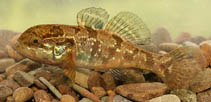http://www.fishbase.org/Summary/speciesSummary.php?genusname=Perccottus&speciesname=glenii ---> http://52.67.158.155/Summary/speciesSummary.php?genusname=Perccottus&speciesname=glenii
http://52.67.158.155/Summary/speciesSummary.php?genusname=Perccottus&speciesname=glenii ---> https://fishbase.net.br/Summary/speciesSummary.php?genusname=Perccottus&speciesname=glenii
https://fishbase.net.br/Summary/speciesSummary.php?genusname=Perccottus&speciesname=glenii ---> https://fishbase.net.br/summary/Perccottus-glenii.html
Perccottus glenii, Chinese sleeper : fisheries, aquarium

You can
sponsor
this page
Common name (e.g. trout)
Genus + Species (e.g. Gadus morhua)
-

-
About this page
-
Languages
-
User feedbacks
-
Citation
-
Uploads
-
Related species
-


 Chinese sleeper
Upload your
photos
and
videos
Chinese sleeper
Upload your
photos
and
videos
Pictures
|
Google image
 Perccottus glenii
Perccottus glenii
Picture by
Sediva, A.
Teleostei (teleosts) >
Gobiiformes
(Gobies) >
Odontobutidae
(Freshwater sleepers)
Etymology:
Perccottus:
Greek, perke = perch + Gr, kottos = a fish (Ref.
45335
)
.
More on author:
Dybowski
.
Environment: milieu / climate zone / depth range / distribution range
Ecology
Freshwater; brackish; demersal. Temperate; 15°C - 30°C (Ref.
2059
); 54°N - 39°N, 106°E - 141°E
Asia: Tugur (Sea of Okhotsk) and Amur southward to Yangtze and Fujian. In Amur, historically known from the middle and lower Amur (from Tygda Rive down to the estuary) with tributaries Zeya, Sungari, Ussuri and the Khanka Lake basin. Reported from Shilka in the upper Amur where it is introduced (Ref.
82587
). Introduced in Europe (Ref.
59043
). At least one country reports adverse ecological impact after introduction (Ref.
2058
).
Length at first maturity / Size / Weight / Age
Maturity: L
m
7.0
, range 6 - 8 cm
Max length : 25.0 cm TL male/unsexed; (Ref.
2059
); max. published weight: 250.00 g (Ref.
80031
); max. reported age: 7 years (Ref.
56557
)
Dorsal
spines
(total): 6 - 8;
Dorsal
soft rays
(total): 9-11;
Anal
spines
: 1-3;
Anal
soft rays
: 7 - 10. Distinguished from other European freshwater species by the following characters: 2 dorsals with the first with 6-8 simple rays, and the second with 2-3 simple and 8-12 branched rays; no spines on first dorsal; no barbels; pelvics not fused into a disc; no lateral line canals; males during spawning period, develop a hump on nape and become black with bright green spots on body and unpaired fins (Ref.
59043
).
Occurs in lentic waters, lakes, ponds, backwaters and marshes with dense underwater vegetation and avoids river stretches with fast and even slow current (Ref.
59043
). Prefers stagnant rivers and bogs (Ref.
80031
). Can tolerate poorly oxygenated water and able to survive in dried out or completely frozen water bodies by digging itself into mud where it hibernates. A voracious predatory fish (wide variety of invertebrates, tadpoles and fish) constituting a most serious threat to aquatic fauna wherever it occurs. In small water bodies; known to extirpate almost all other fish species and amphibian larvae. Spawns for the first time at 1-3 years and about 6.0 cm SL. Spawns several potions of eggs in May to June at 15-20°C. Elongated eggs (3.8 x 1.3 mm) with sticky filaments usually deposited in one row close to water surface on underwater structures such as roots, leaves and others. Males guard the eggs and pelagic larvae (Ref.
59043
).
Spawns several portions of eggs (Ref.
59043
).
Berg, L.S.
, 1965. Freshwater fishes of the U.S.S.R. and adjacent countries. volume 3, 4th edition. Israel Program for Scientific Translations Ltd, Jerusalem. (Russian version published 1949). (Ref.
2058
)
IUCN Red List Status (Ref.
130435
)
Least Concern (LC)
; Date assessed:
09 March 2020
CITES
Not Evaluated
Not Evaluated
Threat to humans
Potential pest
Human uses
Fisheries: minor commercial; aquarium: potential
FAO - Publication:
search
|
FishSource
|
More information
Countries
FAO areas
Ecosystems
Occurrences
Introductions
Stocks
Ecology
Diet
Food items
Food consumption
Ration
Common names
Synonyms
Metabolism
Predators
Ecotoxicology
Reproduction
Maturity
Spawning
Spawning aggregation
Fecundity
Eggs
Egg development
Age/Size
Growth
Length-weight
Length-length
Length-frequencies
Morphometrics
Morphology
Larvae
Larval dynamics
Recruitment
Abundance
BRUVS
References
Aquaculture
Aquaculture profile
Strains
Genetics
Electrophoreses
Heritability
Diseases
Processing
Nutrients
Mass conversion
Collaborators
Pictures
Stamps, Coins Misc.
Sounds
Ciguatera
Speed
Swim. type
Gill area
Otoliths
Brains
Vision
Tools
Bio-Quiz
|
E-book
|
Field guide
|
Length-frequency wizard
|
Life-history tool
|
Point map
|
Classification Tree
|
Catch-MSY
|
Special reports
Check for Aquarium maintenance
|
Check for Species Fact Sheets
|
Check for Aquaculture Fact Sheets
Download XML
Summary page
|
Point data
|
Common names
|
Photos
Internet sources
AFORO (otoliths) |
Alien/Invasive Species database
|
Aquatic Commons
|
BHL
|
Cloffa
|
BOLDSystems
|
Websites from users
|
Check FishWatcher
|
CISTI
|
Catalog of Fishes
:
genus
,
species
|
DiscoverLife
|
ECOTOX
| FAO - Publication:
search
|
Faunafri
| Fishipedia |
Fishtrace
| GenBank:
genome
,
nucleotide
|
GloBI
|
Google Books
|
Google Scholar
|
Google
| IGFA World Record |
MitoFish
|
National databases
|
Otolith Atlas of Taiwan Fishes
|
PubMed
| Reef Life Survey | Socotra Atlas |
Tree of Life
| Wikipedia:
Go
,
Search
| World Records Freshwater Fishing |
Zoobank
|
Zoological Record
Estimates based on models
Phylogenetic diversity index (Ref.
82804
): PD
50
= 1.0000 [Uniqueness, from 0.5 = low to 2.0 = high].
Bayesian length-weight: a=0.01072 (0.00626 - 0.01833), b=3.09 (2.94 - 3.24), in cm total length, based on LWR estimates for this species & (Sub)family-body (Ref.
93245
).
Trophic level (Ref.
69278
): 3.6 ±0.54 se; based on food items.
Generation time: 8.5 ( na - na) years. Estimated as median ln(3)/K based on 1
growth studies.
Resilience (Ref.
120179
): Low, minimum population doubling time 4.5 - 14 years (Preliminary K or Fecundity.).
Fishing Vulnerability (Ref.
59153
): Moderate to high vulnerability (51 of 100).
Price category (Ref.
80766
):
Unknown
.
Back to Search
Random Species
Back to Top
Accessed through:
Not available
FishBase mirror site :
Laguna, Philippines
Page last modified by :
mrius-barile
|